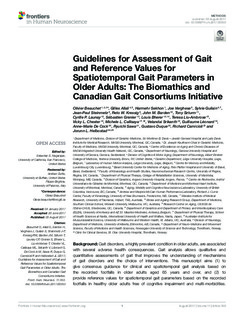| dc.contributor.author | Beauchet, Oliver | |
| dc.contributor.author | Allali, Gilles | |
| dc.contributor.author | Sekhon, Harmehr | |
| dc.contributor.author | Verghese, Joe | |
| dc.contributor.author | Guilain, Sylvie | |
| dc.contributor.author | Steinmetz, Jean-Paul | |
| dc.contributor.author | Kressig, Reto W. | |
| dc.contributor.author | Barden, John M. | |
| dc.contributor.author | Szturm, Tony | |
| dc.contributor.author | Launay, Cyrille P. | |
| dc.contributor.author | Grenier, Sébastien | |
| dc.contributor.author | Bherer, Louis | |
| dc.contributor.author | Liu-Ambrose, Teresa | |
| dc.contributor.author | Chester, Vicky L. | |
| dc.contributor.author | Callisaya, Michele L. | |
| dc.contributor.author | Srikanth, Velandai | |
| dc.contributor.author | Léonard, Guillaume | |
| dc.contributor.author | De Cock, Anne-Marie | |
| dc.contributor.author | Sawa, Ryuichi | |
| dc.contributor.author | Duque, Gustavo | |
| dc.contributor.author | Camicioli, Richard | |
| dc.contributor.author | Helbostad, Jorunn L. | |
| dc.date.accessioned | 2018-01-02T15:38:01Z | |
| dc.date.available | 2018-01-02T15:38:01Z | |
| dc.date.created | 2017-12-05T10:25:16Z | |
| dc.date.issued | 2017 | |
| dc.identifier.citation | Frontiers in Human Neuroscience. 2017, 11:353 1-14. | nb_NO |
| dc.identifier.issn | 1662-5161 | |
| dc.identifier.uri | http://hdl.handle.net/11250/2474165 | |
| dc.description.abstract | Background: Gait disorders, a highly prevalent condition in older adults, are associated with several adverse health consequences. Gait analysis allows qualitative and quantitative assessments of gait that improves the understanding of mechanisms of gait disorders and the choice of interventions. This manuscript aims (1) to give consensus guidance for clinical and spatiotemporal gait analysis based on the recorded footfalls in older adults aged 65 years and over, and (2) to provide reference values for spatiotemporal gait parameters based on the recorded footfalls in healthy older adults free of cognitive impairment and multi-morbidities.
Methods: International experts working in a network of two different consortiums (i.e., Biomathics and Canadian Gait Consortium) participated in this initiative. First, they identified items of standardized information following the usual procedure of formulation of consensus findings. Second, they merged databases including spatiotemporal gait assessments with GAITRite® system and clinical information from the “Gait, cOgnitiOn & Decline” (GOOD) initiative and the Generation 100 (Gen 100) study. Only healthy—free of cognitive impairment and multi-morbidities (i.e., ≤ 3 therapeutics taken daily)—participants aged 65 and older were selected. Age, sex, body mass index, mean values, and coefficients of variation (CoV) of gait parameters were used for the analyses.
Results: Standardized systematic assessment of three categories of items, which were demographics and clinical information, and gait characteristics (clinical and spatiotemporal gait analysis based on the recorded footfalls), were selected for the proposed guidelines. Two complementary sets of items were distinguished: a minimal data set and a full data set. In addition, a total of 954 participants (mean age 72.8 ± 4.8 years, 45.8% women) were recruited to establish the reference values. Performance of spatiotemporal gait parameters based on the recorded footfalls declined with increasing age (mean values and CoV) and demonstrated sex differences (mean values).
Conclusions: Based on an international multicenter collaboration, we propose consensus guidelines for gait assessment and spatiotemporal gait analysis based on the recorded footfalls, and reference values for healthy older adults. | nb_NO |
| dc.language.iso | eng | nb_NO |
| dc.publisher | Frontiers Media | nb_NO |
| dc.rights | Navngivelse 4.0 Internasjonal | * |
| dc.rights.uri | http://creativecommons.org/licenses/by/4.0/deed.no | * |
| dc.title | Guidelines for assessment of gait and reference values for spatiotemporal gait parameters in older adults: The biomathics and canadian gait consortiums initiative | nb_NO |
| dc.type | Journal article | nb_NO |
| dc.type | Peer reviewed | nb_NO |
| dc.description.version | publishedVersion | nb_NO |
| dc.source.pagenumber | 1-14 | nb_NO |
| dc.source.volume | 11:353 | nb_NO |
| dc.source.journal | Frontiers in Human Neuroscience | nb_NO |
| dc.identifier.doi | 10.3389/fnhum.2017.00353 | |
| dc.identifier.cristin | 1522833 | |
| dc.description.localcode | Copyright © 2017 Beauchet, Allali, Sekhon, Verghese, Guilain, Steinmetz, Kressig, Barden, Szturm, Launay, Grenier, Bherer, Liu-Ambrose, Chester, Callisaya, Srikanth, Léonard, De Cock, Sawa, Duque, Camicioli and Helbostad. This is an open-access article distributed under the terms of the Creative Commons Attribution License (CC BY). | nb_NO |
| cristin.unitcode | 194,65,30,0 | |
| cristin.unitname | Institutt for nevromedisin og bevegelsesvitenskap | |
| cristin.ispublished | true | |
| cristin.fulltext | original | |
| cristin.qualitycode | 1 | |

